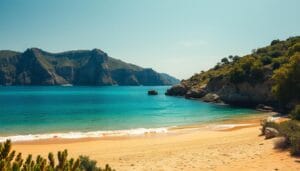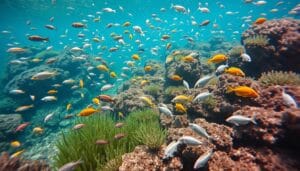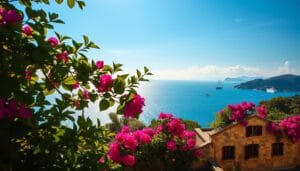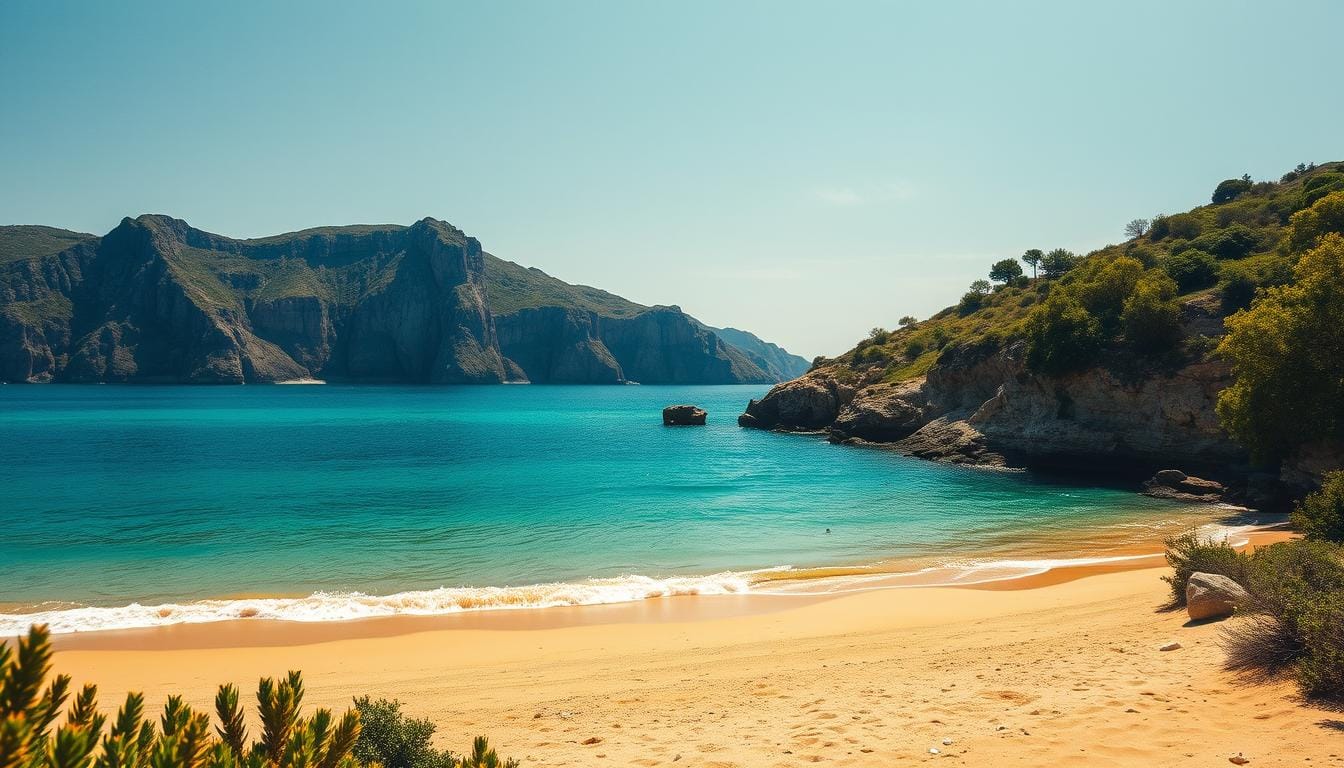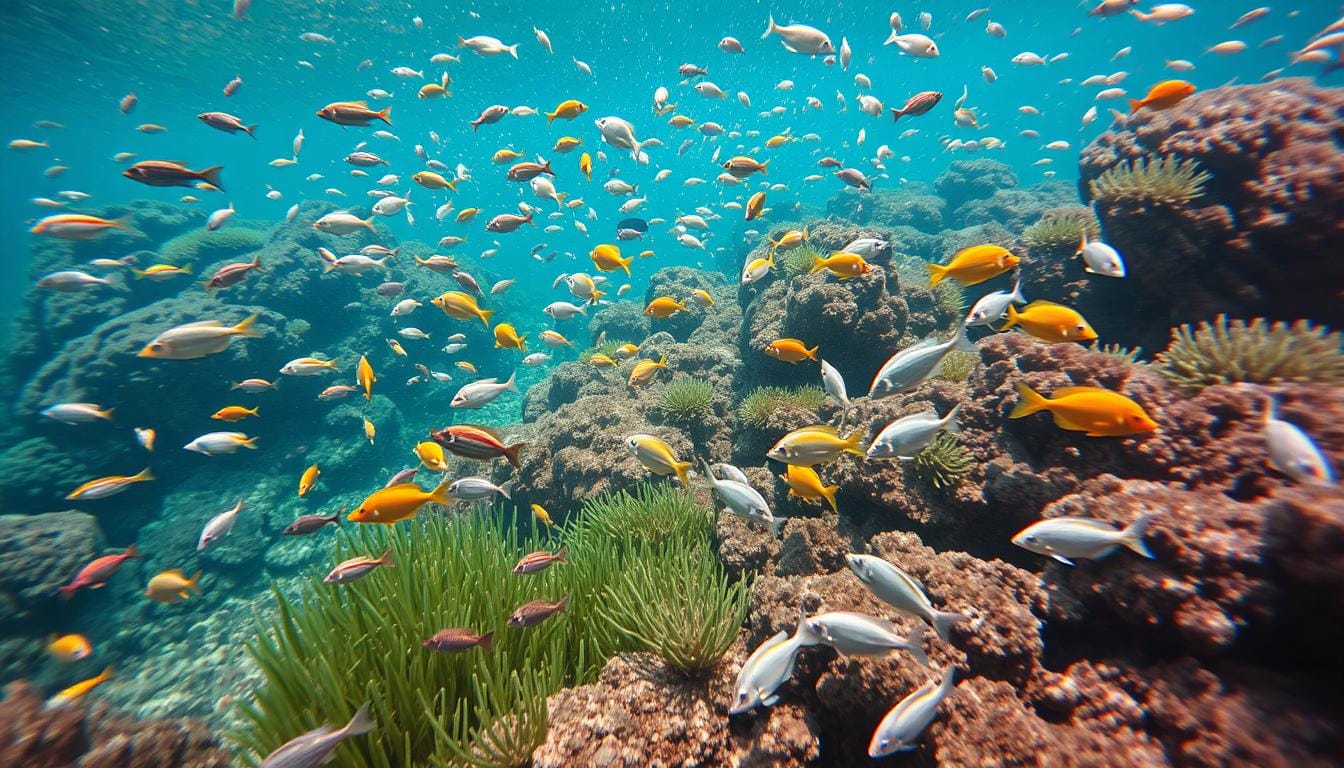“In every walk with nature one receives far more than he seeks.” — John Muir.
We open this guide with a clear, friendly promise: we help you spot and name the most common marine life near the island. Our aim is simple — reliable tips for travelers who want quick answers about what swims in the sea and lagoon edges today.
Why this place is special: the island sits where the mediterranean sea meets broader atlantic ocean influence, so you get a rich mix of coastal animals and memorable encounters. We point out habitats — rocky coves, seagrass beds, sandy flats, estuaries — and match each spot to the names you’ll hear in tavernas and on boat trips.
Expect short, practical notes on common names like branzino and gilthead bream, respectful viewing of seals, and simple safety tips for water visits. This intro sets the tone: curious, practical, and travel-friendly.
Table of Contents
ToggleKey Takeaways
- We offer a quick, trustworthy overview for travelers who want to know what lives in local waters.
- The island’s position mixes mediterranean sea and atlantic ocean influences, boosting diversity.
- Habitats—rocks, seagrass, sand, estuaries—match specific names and sightings.
- Look for popular edible names and respectful wildlife viewing tips for seals and other animals.
- The guide is practical: short tips, local context, and easy plans for shore-based exploration.
Why Corfu’s Waters Are a Hotspot for Marine Life Today
A mix of currents and coastal shapes makes this coastline unusually rich in marine life today. We see overlapping ranges where the Mediterranean Sea meets influences from the eastern Atlantic. That meeting brings a wider array of fish and other marine animals into nearshore zones.
Mediterranean meets Eastern Atlantic: a crossroads of life
Many familiar names—Sparus aurata, Lithognathus mormyrus, Dicentrarchus labrax, Mugil cephalus, and Mullus spp.—travel between the two systems. Currents and temperature shifts let these species use both shallow bays and more open water as seasons change.
From shallow coves to lagoons: multiple habitats
Sunlit seagrass meadows, rocky ledges, sandy bottoms, and river mouths form a mosaic of natural habitat. Each patch supports different names you’ll learn quickly—sea bass, sea bream, and mullet show up in predictable places.
| Habitat | Typical names | Why it matters |
|---|---|---|
| Posidonia meadows | Juvenile sea bream, mullet | Nursery shelter and food |
| Rocky shores | Sea bass, wrasse | Foraging and protection |
| Estuaries & lagoons | Mullet, juvenile sea bass | Seasonal feeding hubs |
- Pick calm days for clearer water and better sightings.
- Look near river mouths in warm months for schooling action.
- Learn a few local names—then you’ll spot them by length and shape.
Corfu Fish Species
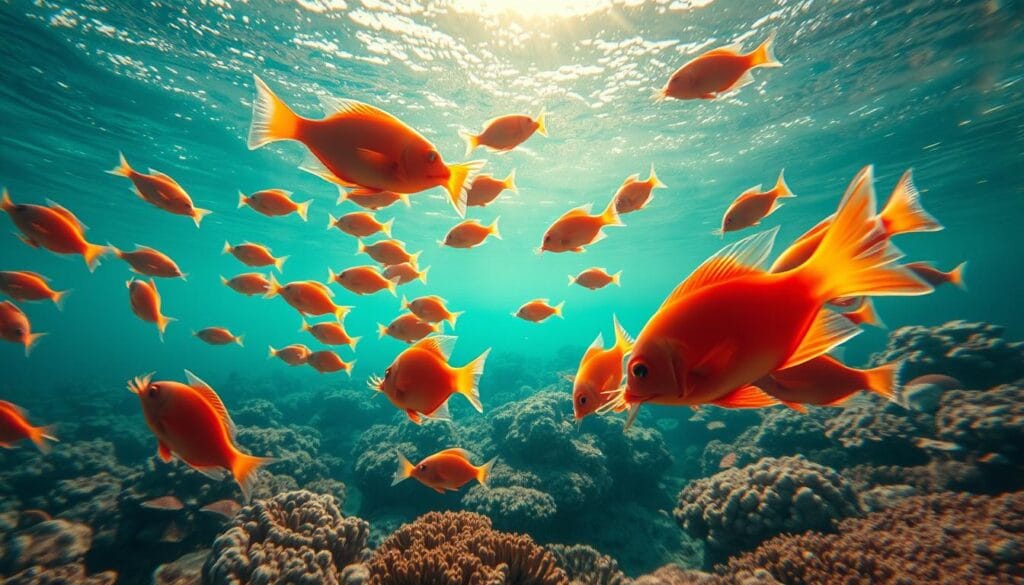
Along the shoreline we find three clear groups that shape what you’ll see in the water.
Saltwater, brackish, and freshwater around the island
Saltwater residents patrol rocky reefs and sandy flats—names like Diplodus sargus, Sparus aurata, and Dicentrarchus labrax are common. Brackish mouths and lagoons hold mullet and adaptable nibblers. Clear streams host true freshwater fish such as the European bullhead and eels that move between habitats.
How family groups shape behavior and habitat use
Families matter. Sparidae graze seagrass and pick on algae. Moronidae (sea bass) shift from invertebrates to eating other small fish as they grow. Mugilidae (mullet) sift sand and mud, while Soleidae bury on flat bottoms to ambush prey.
| Group | Typical name | Habitat | Why watch |
|---|---|---|---|
| Saltwater | Sea bream, sea bass, red mullets | Reefs, seagrass, sandy bays | Foraging and schooling visible in calm water |
| Brackish | Mullet, corfu toothcarp | Lagoons and estuary mouths | Nursery zones for juveniles and small fish |
| Freshwater | European bullhead, eels | Streams, spring-fed channels | Hidden but key to river food webs |
- Read the shoreline—seagrass, sand tongues, or a trickling stream predicts the common name you’ll hear locally.
- Plan visits on calm days for better water clarity and longer sightings of behavior and length cues.
- Listen for locals—rare toothcarp mentions point to brackish pockets worth exploring.
Inside Corfu’s Habitats: Sea, Lagoons, Estuaries, and Rivers
Along the shoreline we find clear pockets where life gathers—meadows, ledges, and soft sand each tell a different story.
Natural habitat snapshots: Posidonia and Zostera beds shelter annular seabream and juveniles of other names. Sandy and muddy bottoms host Mullus spp. and Solea solea, where red mullet sift with their whisker-like barbels.
Rocky shores attract Diplodus sargus and other deep-bodied names that pivot around crevices. Length and body shape often reveal behavior—rounded bream hug rocks, flat soles settle into sand.
Lagoons and river mouths function as nurseries. Shallow, sun-warmed water draws shoals to feed and shelter. Mixes of fresh and sea water speed growth and lure visiting hunters at dusk.
Freshwater trickles and vegetated margins can hold the corfu toothcarp and other toothcarp near calm edges. Eels move between fresh and marine water, using channels to commute at night.
- Quick tip: pick a sheltered cove on windy days for clearer views.
- Observe slowly: gentle ripples and patchy seagrass often mean schools are nearby.
Seabreams You’ll See: White, Annular, Gilthead, and Sand Steenbras
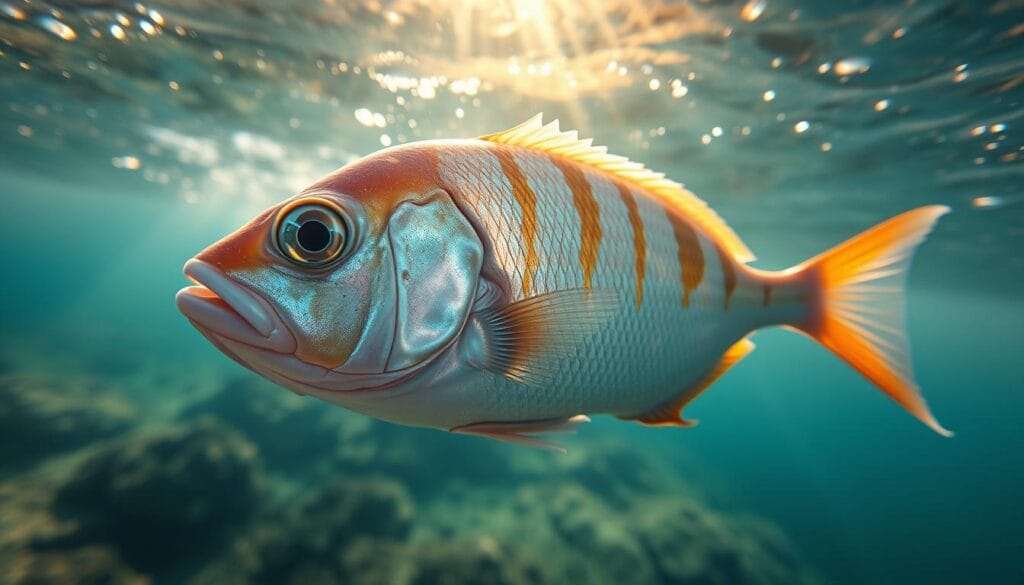
Dawn light often brings the first seabream into shallow coves where rocks meet seagrass. Here we show where to look, what each name means, and how to tell them apart by length, size, and behavior.
White seabream (Diplodus sargus)
White seabream favor rocky bottoms and Posidonia beds. They often visit inshore at dawn. Look near boulders and weed edges for quick, silver-bodied individuals. Their compact length and quick turns make them easy to spot from a quiet cove.
Annular seabream (Diplodus annularis)
Annular seabream dwell chiefly in Zostera and Posidonia patches, and on sandy flats. They feed on worms, crustaceans, mollusks, echinoderms, and hydrozoans. Midday sun highlights their patterns against seagrass, so plan some calm, bright hours ashore.
Gilthead sea bream (Sparus aurata)
The gilthead ranges across the Mediterranean Sea and eastern Atlantic Ocean. You’ll know it by the golden bar between the eyes. This well-known food fish grows larger and shows a deeper body than its cousins. Locals prize it on menus—grilled simply, it’s a lasting taste memory.
Sand steenbras (Lithognathus mormyrus)
Sand steenbras form schools over pale sand, estuaries, and seagrass meadows. They feed on benthic invertebrates and show a fascinating protandric life cycle—individuals mature first as males, then later become females. Spot mixed-size groups to see that change in action.
- Where to look: white seabream at first light around rocks; annular near seagrass; gilthead in bays and near boat moorings; sand steenbras on sandy ground.
- What they eat: invertebrates plucked from algae, sand, and seagrass drive close-shore feeding.
- How to ID: note length and body depth—smaller, quick fish at blade tips; larger, deeper-bodied bream between boulders.
Sea Bass in Shallow Waters: The European Branzino
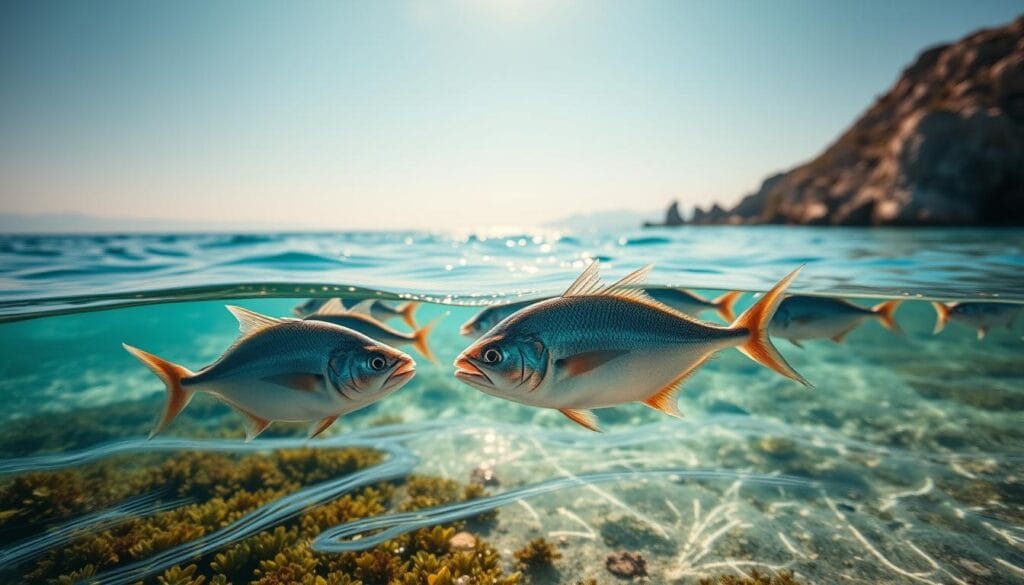
When the sun warms shallow bays, young sea bass gather in loose schools and become easy to spot. We watch them near river mouths, estuaries, and lagoon entrances through the warm months.
Seasonal moves between estuaries, lagoons, and offshore
Summer: juveniles use rivers and lagoons as nurseries. Winter: adults migrate offshore toward the atlantic ocean and deeper sea when storms arrive.
Diet shift from invertebrates (juveniles) to fish (adults)
Young branzino feed on tiny invertebrates while schooling in shallow bays. As they grow, they adopt a more solitary life and take small fish along rocky edges and pilings.
- Best time to watch: falling tide at a lagoon mouth for concentrated activity.
- Length and profile: juveniles dart in quick bursts; mature individuals glide with a steady, deeper body.
- Food note: branzino on menus may be farmed or line-caught—ask about sourcing.
| Season | Habitat | Typical diet |
|---|---|---|
| Summer | Rivers, lagoons, estuaries | Invertebrates (juveniles) |
| Winter | Offshore, deeper water | Small fish (adults) |
Mullets of Corfu: Flathead Grey Mullet and Relatives
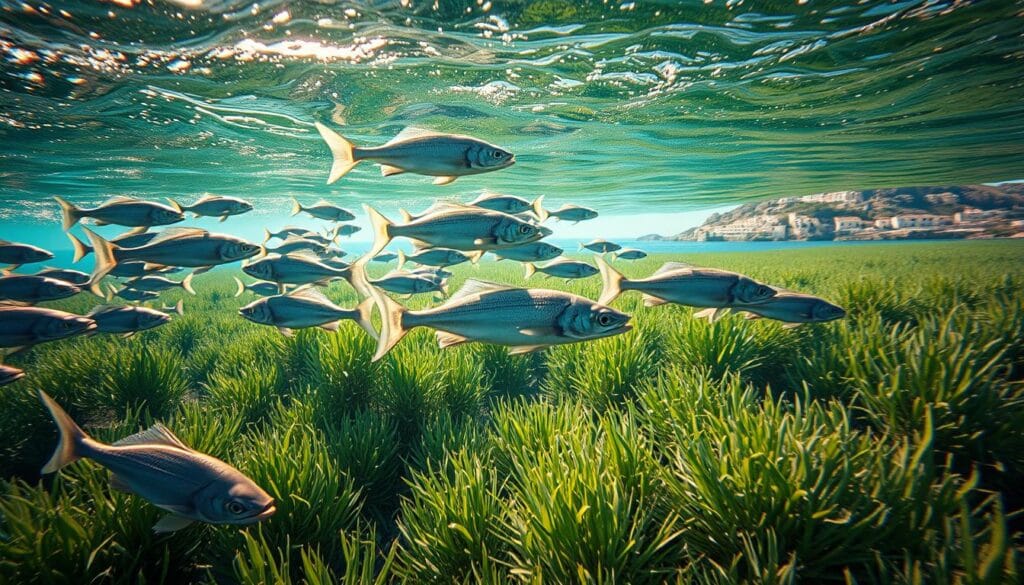
Look for a sudden flash of silver—often a mullet school on the move across a sand plain. We introduce the fast-moving schools you’ll see over sand and mud. They sweep shallows in tight groups and are easy to note from a quiet shoreline.
Flathead grey mullet (Mugil cephalus): euryhaline habits and algae feeding
Flathead grey mullet are highly adaptable. They move between coastal waters, estuaries, and freshwater stretches to feed.
Adults often graze on algae and detritus. Individuals can reach up to 100 cm in length, so size within a school varies noticeably.
Liza ramada: inshore pelagic life, lagoons, and autumn reproduction
Liza ramada lives in inshore pelagic zones and lagoons. Their movements increase in autumn when reproduction peaks from October to December.
Both kinds show silvery flanks with faint lateral stripes. Their torpedo bodies and steady cruising make the name easy to match with what you see.
- How to spot them: stand back, let the water settle, then scan for a silver line moving in unison.
- What they eat: skimming algae and detritus—often nosing the mud or cruising sandbars.
- Ask locally: if a catch is on a menu, ask which family or name it came from to link taste with habitat.
Special Mentions: Salema Porgy, Red Mullets, and Sole
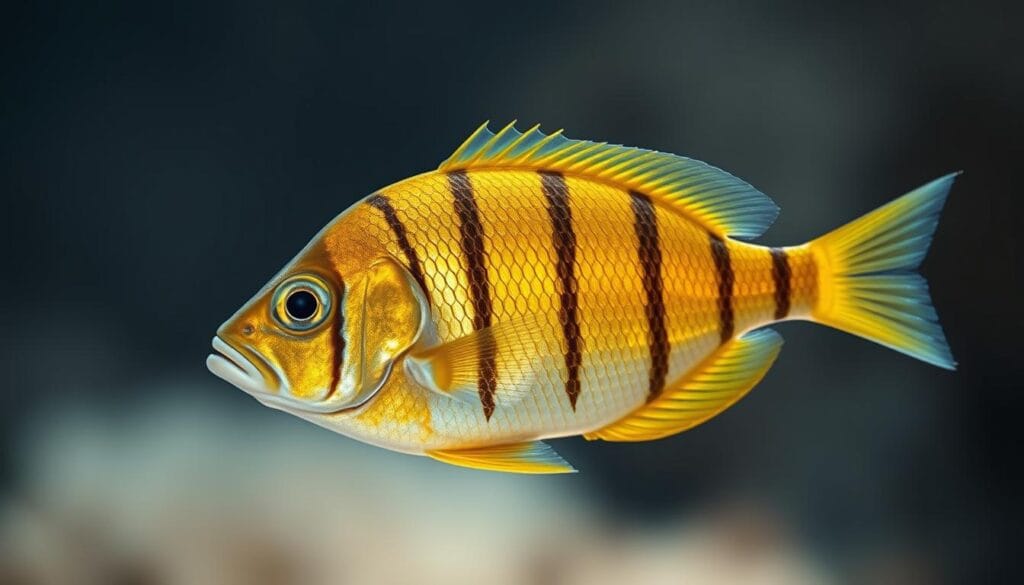
Some coastal dwellers carry colorful markings or curious habits that travelers should know. We’ll cover three common names that stand out for appearance, behavior, and a few safety notes.
Salema porgy (Sarpa salpa)
The salema porgy shows unmistakable gold stripes along its flank. Its bold look makes ID easy from a short distance.
Traveler caution: rare cases of ichthyoallyeinotoxism have been reported after eating certain parts—especially viscera. The risk likely comes from algae the animal eats in the mediterranean sea, so ask what part is served if you see this name on a menu.
Red mullets (Mullus spp.)
Red mullets forage over soft sand using sensitive chin barbels—think tiny whiskers that probe for worms and crustaceans. They often feed in small groups on gently sloping bottoms.
Seine nets can catch many during spawning, so these small fish sometimes appear in local catches and menus. For spotting, try mid-morning in shallow waters with pale sand.
Common sole (Solea solea)
The common sole lies semi-immersed in sand or mud, with both eyes on the right side. It vanishes into the seabed until it springs up to snatch small prey.
Look for subtle outlines in calm, shallow waters. Move slowly when you swim—steady motion spooks them less and gives you a better sense of length and size.
- Menu tip: favor simple grilled preparations for clean flavor, and confirm the part of the animal served for salema porgy.
- Field tip: gentle surf can reveal fresh foraging patches as sand stirs—then watch for mullet and sole returning once the sea settles.
Eels and Freshwater Neighbors: Rivers to Sea
Twilight and moonless nights reveal a hidden corridor where eels slip between river roots and coastal rocks. We introduce the quiet link between upland streams and nearby bays, and why watching at dusk pays off for curious travelers.
Eels (Anguilliformes): nocturnal predators across fresh and salt water
Eels include many different species. They often hunt after dark with elongated bodies and fused fins that move in a serpentine wave. Some are catadromous—living in freshwater for years, then returning to the open sea to breed.
We note how to spot them: slow, ribbon-like motion and tight turns around rocks. Estimating their length is hard when they hide in crevices, so patience at dusk is key.
European bullhead (Cottus gobio): small riverine sculpin with big role in food webs
The European bullhead lives in cold, clear streams and shallow rivers. This small, broad-headed animal feeds on benthic invertebrates and helps steady local food chains.
During spring, males guard nests—so avoid lifting stones or disturbing gravel. Quiet observation of clear pools reveals these hidden behaviors without harm.
- Look low from the bank, kneel, and scan under cut roots for shadowy small fish.
- Remember the local name for a resident when asking guides—simple names help you match sightings to what locals call them.
- Respect nurseries: what begins in freshwater often fuels life at the edge, drawing predators into nearshore waters.
Top Predators and Notable Wildlife in Corfu’s Marine Web
Top predators define the edge of any healthy marine web, and here we meet the most notable ones. We focus on the monk seal and the larger hunters that link bottom life to visible shore activity.
Mediterranean monk seal (Monachus monachus)
The monk seal is an elusive, cave-dwelling hunter. Adults reach a length of 2–3 m and can weigh up to 350 kg.
Males tend to be darker and show a white belly patch; females are slightly smaller. Births occur August–December, with peaks in September–October.
What fuels the top of the web
These seals feed on a variety of food—octopus, cuttlefish, and many small fish among others. Fast coastal hunters also rely on invertebrates and juvenile fish that start low in the chain.
- Breeding caves: isolated rocky coasts with beach access; pups may be swept by autumn storms.
- Behavior: seals are polygynous and secretive—quiet, distant viewing is essential.
- Conservation tip: keep coves peaceful, avoid loud entries, and let wildlife lead the encounter.
| Predator | Typical diet | Preferred habitat |
|---|---|---|
| Mediterranean monk seal | Octopus, cuttlefish, small fish | Inaccessible sea caves and rocky shores |
| Coastal predatory fish | Juvenile fish, crustaceans | Estuaries, lagoons, rocky ledges |
| Seabirds and others | Small fish, invertebrates | Cliffs, shorelines, nearshore waters |
Where and When to Spot Fish Around Corfu
A few quiet steps from the car often lead straight to lively shallows where movement tells the story. We map simple shore entries and best time windows so you waste no time.
Shore entries: rocky coves, seagrass beds, and estuaries
Rocky coves bring white seabream in close at dawn. Watch near boulders and ledges for quick silver flashes.
Seagrass beds hold mixed schools; late afternoon light highlights small fish along blade tips.
Estuaries and lagoon mouths concentrate juveniles in summer and offer active scenes at tide changes in shallow waters.
Best time windows: dawn inshore activity and seasonal lagoon use
Dawn often brings white seabream close, while late summer afternoons draw sea bass and mullet to clear seams.
Look for silver flashes that reveal flathead grey mullet or grey mullet, and longer glides that signal a hunting sea bass.
Tiny ripples near reeds may hide the corfu toothcarp or other toothcarp—pause and you may see them dart.
- Quick checklist: mask defogged, slow entry, wide view before choosing direction.
- Logistics: park above a protected cove and plan extra time for lingering when conditions are perfect.
| Entry | What to expect | Best time |
|---|---|---|
| Rocky cove | White seabream, mixed wrasse | Dawn |
| Seagrass | Small schooling fish, juvenile bream | Late afternoon |
| Estuary / lagoon mouth | Sea bass, flathead grey mullet, grey mullet | Late summer, tidal change |
Eat Responsibly: Sustainable Seafood Notes for Visitors from the United States
We want your meals to be memorable—and mindful. Many local seafood stocks face pressure from overfishing, so quick questions at a taverna help protect habitats and support small-scale fishers.
Why season and method matter. Ask how the food fish were caught and what time of year they’re best. Certain gears—like seine nets—can take spawning red mullet and mixed hauls that harm juvenile stocks. Organizations such as WWF, Greenpeace, Archipelagos, and iSea publish simple guides to current seasons and sustainable gear choices.
Know common menu names. Sea bass is also known in the U.S. as branzino. Gilthead sea bream appears as dorade. Local breams may use several Greek names—ask your server to match the name to the catch and whether it’s farmed or wild.
- Ask: “How were these fish caught?” and “What time of year were they landed?”
- Prefer line-caught or day-boat options over large mixed hauls when possible.
- Smaller size portions from selective methods often beat big mixed nets for sustainability.
- For delicate taxa like red mullet, favor local, selective methods to avoid taking spawning groups.
| Question to ask | Why it matters | Good answer |
|---|---|---|
| How was this fish caught? | Method affects bycatch and juvenile loss | Line-caught, day-boat, or trap |
| Is it farmed or wild? | Farming can reduce pressure but has trade-offs | Farmed (traceable) or wild (sustainably landed) |
| When was it landed? | Season affects spawning and stock health | Recently landed, not during closed seasons |
Final tip: celebrate simple preparations—grilled whole with lemon and olive oil—so local taste and quality shine. We encourage checking quick guides from conservation groups before ordering; a small question can guide better choices for years to come.
Conclusion
The coastline rewards curiosity—small steps, quiet timing, and a basic ID rule will show you more than you expect.
We close with the big picture: this compact shore hosts a surprising variety of animal life that links local bays to the eastern atlantic and waters worldwide.
Many coastal names—like flathead grey mullet and the corfu toothcarp—range into subtropical waters and beyond. Life histories span years and cross freshwater and marine zones.
Plan dawn visits or slack tides to note size and length differences in passing schools. Learn a family trait—bream, mullet, or sole—and you’ll match sightings to names faster today.
Takeaway: read the shoreline, choose calm coves, taste responsibly, and enjoy the small rewards of patient observation.
FAQ
What makes Corfu’s waters rich in marine life today?
The island sits where Mediterranean and eastern Atlantic influences meet, creating varied salinity and temperature profiles. That mix, plus habitats like seagrass meadows, rocky shores, sandy bottoms, lagoons and river mouths, supports a wide array of animals from small invertebrates to larger predators.
Which types of water habitats should visitors explore to see the most variety?
Shallow coves with Posidonia beds, sheltered lagoons, estuaries where rivers enter the sea, and rocky shorelines all host different communities. Dawn and dusk inshore visits often reveal active feeding by juveniles and adults.
Are there freshwater and brackish residents as well as open‑sea ones?
Yes. Alongside coastal and pelagic residents, river mouths and coastal lagoons host euryhaline and freshwater‑tolerant animals — for example, small toothcarp and riverine sculpins that use these nursery areas.
Which common coastal fish are likely on local menus?
Local restaurants often list branzino (European sea bass), dorade or gilthead bream, and various mullets. These are popular both as caught food fish and in regional cuisine — seasonal availability matters for sustainability.
What are the distinguishing habits of mullets around the island?
Flathead grey mullet and related Liza species tolerate wide salinity ranges and feed mainly on algae and detritus. They frequent inshore waters, lagoons, and estuaries and can form schools in shallow areas.
How do seabreams differ in where they live and feed?
White seabream favor rocky coasts, annular seabream forage among seagrass, gilthead sea bream appears inshore and near reefs and is prized as food, while sand steenbras prefers sandy bottoms and often forms schools; each uses habitat features to find prey and shelter.
When and where is the best time to spot European sea bass (branzino)?
Branzino move seasonally between estuaries, lagoons and offshore grounds. Look for them in shallow waters and river mouths during warmer months, especially around dawn when juveniles hunt invertebrates and adults shift to fish prey.
Are there warnings about eating certain local species?
Some species, like salema porgy, have been associated with occasional toxic effects if consumed in large amounts due to natural compounds they can accumulate. We recommend following local guidance and choosing sustainably sourced menu items.
What role do eels and other migratory animals play in coastal ecosystems?
Eels are nocturnal predators that move between fresh and salt water, linking river and sea food webs. Migratory and amphidromous animals help transfer energy and nutrients across habitats, supporting larger predators and fisheries.
How can visitors support sustainable seafood practices here?
Choose seasonal catches, ask about fishing methods, prefer species listed as sustainable, and avoid undersized or out‑of‑season items. Local fishmongers and restaurants can often suggest eco‑friendly options like responsibly caught branzino or certified bream.
